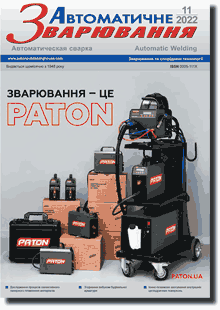| 2022 №11 (08) |
DOI of Article 10.37434/as2022.11.01 |
2022 №11 (02) |

Журнал «Автоматичне зварювання», № 11, 2022, с. 7-11
Особливості впливу границь зерен при δ-γ-перетворенні на формування структури металу зварних швів (Огляд)
В.В. Головко
ІЕЗ ім. Є.О. Патона НАН України. 03150, м. Київ, вул. Казимира Малевича, 11. E-mail: office@paton.kiev.ua
Викладено огляд літературних результатів досліджень, виходячи з яких видно, що алгоритм моделювання структурного складу металу, прогнозування його механічних властивостей повинен містити опис реакцій з утворення та розвитку дендритної структури. Моделі, які побудовані на опису реакцій γ-α-перетворення, не надають можливості оцінки процесу формування структури як цілісного комплексу – від початку зародження дендритів до кінцевого складу мікроструктури. Наведено результати досліджень, які були виконані в останні десятиліття, щодо впливу інокулювання тугоплавких сполук до розплавів низьколегованих сталей, зокрема, і зварювальної ванни, на розвиток процесів зародження, росту та розпаду дендритів при кристалізації металу. Показано можливості впливу інокулянтів на формування первинної структури з метою підвищення властивостей металу зварних швів. Бібліогр. 22, рис. 3.
Ключові слова: низьколегована сталь, зварювальна ванна, інокулювання, дендрити, аустеніт, первинна структура
Надійшла до редакції 08.09.2022
Список літератури
1. Phelan, D., Dippenaar, R. (2004) Instabilityof the delta-ferrite/ austenite interface in low carbonsteels: The influence of delta-ferrite recovery sub-structures. ISIJ International, 44, 2, 414–421.2. Yin, H., Emi, T., Shibata, H. (1999) Morphological instability ofd-ferrite/g-austenite interphase boundaryin low carbon steels. Acta materials, 47, 5, 1523–1535.
3. Babu, S.S., Vitek, J.M., David, S.A. et al. (2003) Characterization and prediction of austeniteformation and decomposition in steel welds. The Minerals, Metals & Materials Society, 1, 1–10.
4. Bhadeshia, H.K.D.H., Svensson, L.-E. (1993) Modelling the evolution of microstructurein steel weld metal. Mathematical Modelling of Weld Phenomena. Eds H. Cerjak, K. E. Easterling. Institute of Materials, London, pp. 109–182.
5. Strickland, J., Nenchev, B., Dong, H. (2020) On directional dendritic growth and primary spacing – A review. Crystals, 10, 627. doi:10.3390/cryst10070627
6. Richter, G., Rühle, M. (2006) Insight into the atomic-scale mechanism of liquid metal embrittlement. Appl. Phys. Lett. 89, 121911. https://doi.org/10.1063/1.2356322
7. Luo, J., Asl, M., Kiely, C.J., Harmer, M.P. (2011) The role of a bilayer interfacial phase on liquid metal embrittment. Science 23 Sep 2011, 333, 6050, 1730–1733. DOI: 10.1126/ science.1208774
8. Cantwell P.R., Tang M., Dillon S.J. et al. (2014) Grain boundary complexions. Acta Materialia, 62, 1–48.
9. Borisov, V.T., Cherepanov, A.N., Predtechenskii, M.R., Varlamov, Yu.D. (2003) Effect of Wettability on the Behavior of a Liquid Drop after Its Collision with a Solid Substrate. Journal of Applied Mechanics and Technical Physics, 44, 803–808.
10. Rohrer, G.S. (2011) Grain boundary energy anisotropy: a review. Journal of Materials Sciencev, 46, 5881–5895.
11. Mullins, W.W. (1957) Theory of thermal grooving. Journal of Applied Physics, 28, 333. https://doi.org/10.1063/1.1722742
12. Dillon, S.J., Rohrer, G.S. (2009) Mechanism for the development of anisotropic grain boundary character distributions during normal grain growth. Acta Materialia, 57, 1, 1–7.
13. Babu, S.S., Specht, E.D., David, S.A. et al. (2007) Time-Resolved X-ray diffraction investigation of austeniteand transformation to bainite. Proceedings of the 1st International Symposium on Steel Science (IS3-2007). The Iron and Steel Institute of Japan, 93–99.
14. Rohrer, G.S., Anthony, J.G., Rollett D. (2008) A Model for the origin of anisotropic grain boundary character distributions in polycrystalline materials. Applications of Texture Analysis, 17, 10. https://doi.org/10.1002/ 9780470444214.ch36
15. Cahn, J.W. (1977) Critical point wetting. The Journal of Chemical Physics, 66, 8. https://doi.org/10.1063/1.434402
16. Ebner C., Saam W.F. (1977) New phase-transition phenomena in thin argon films. Physical Review Letters, 38, 25, 1486–1489.
17. Straumal, B., Baretzky, B. (2004) Grain boundary phase transitions and their influence on properties of polycrystals. Interface Science, 12, 2-3, 147–155.
18. Chatain, D., Rabkin, E., Derenne, J., Bernardini, J. (2001) Role of the solid/liquid interface faceting in rapid penetration of a liquid phase along grain boundaries. Acta Materialia, 49, 7, 1123–1128.
19. Porter, D.A., Easterling, K.E., Sherif, M.Y. (2009) Transformations in Metals and Alloys. Third edition. by Taylor & Francis Group. CRC Press is an imprint of Taylor & Francis Group. International Standard Book Number-13: 978-1-4398-8357-0 (eBook - PDF).
20. Yang, Y., Luo, S., Wang, P. et al. (2021) Multiphase field modeling of dendritic solidificationof low-carbon steel with peritectic phase transition. The Minerals, Metals & Materials Society and ASM International. https://doi.org/10.1007/ s11663-021-02297-1
21. Suito, H., Ohta, H., Morioka, S. (2006) Refinement of solidification microstructure and austenite grainby fine inclusion particles. ISIJ International, 46, 6, 840–846.
22. Holovko, V.V., Stepanuk, S.M. (2022) Nanoscale modification of weld metal microstructure. Global Journal of Science Frontier Research; 1 Interdisciplinary, 22, 1, 10.
Реклама в цьому номері:
Вартість передплати/замовлення на журнали або окремі статті
| журнал/валюта | річний комплект друкований |
1 прим. друкований |
1 прим. електронний |
одна стаття (pdf) |
| AS/UAH | 1800 грн. | 300 грн. | 300 грн. | 150 грн. |
| AS/USD | 192 $ | 32 $ | 26 $ | 13 $ |
| AS/EUR | 180 € | 30 € | 25 € | 12 € |
| TPWJ/UAH | 7200 грн. | 600 грн. | 600 грн. | 280 грн. |
| TPWJ/USD | 384 $ | 32 $ | 26 $ | 13 $ |
| TPWJ/EUR | 348 € | 29 € | 24 € | 12 € |
| SEM/UAH | 1200 грн. | 300 грн. | 300 грн. | 150 грн. |
| SEM/USD | 128 $ | 32 $ | 26 $ | 13 $ |
| SEM/EUR | 120 € | 30 € | 25 € | 12 € |
| TDNK/UAH | 1200 грн. | 300 грн. | 300 грн. | 150 грн. |
| TDNK/USD | 128 $ | 32 $ | 26 $ | 13 $ |
| TDNK/EUR | 120 € | 30 € | 25 € | 12 € |
AS = «Автоматичне зварювання» - 6 накладів на рік;
TPWJ = «PATON WELDING JOURNAL» - 12 накладів на рік;
SEM = «Сучасна електрометалургія» - 4 наклада на рік;
TDNK = «Технічна діагностика та неруйнівний контроль» - 4 наклада на рік.









